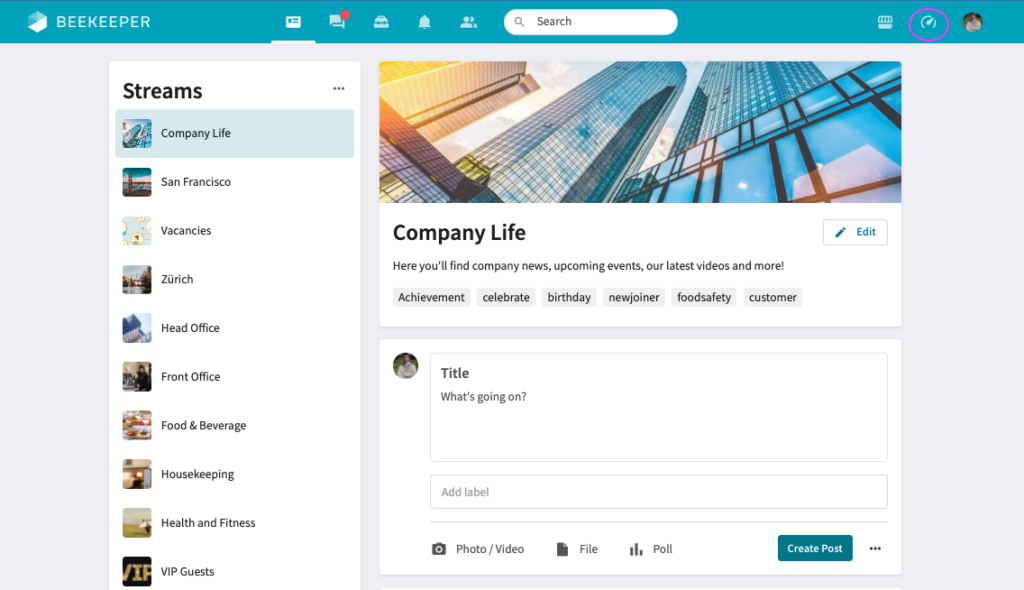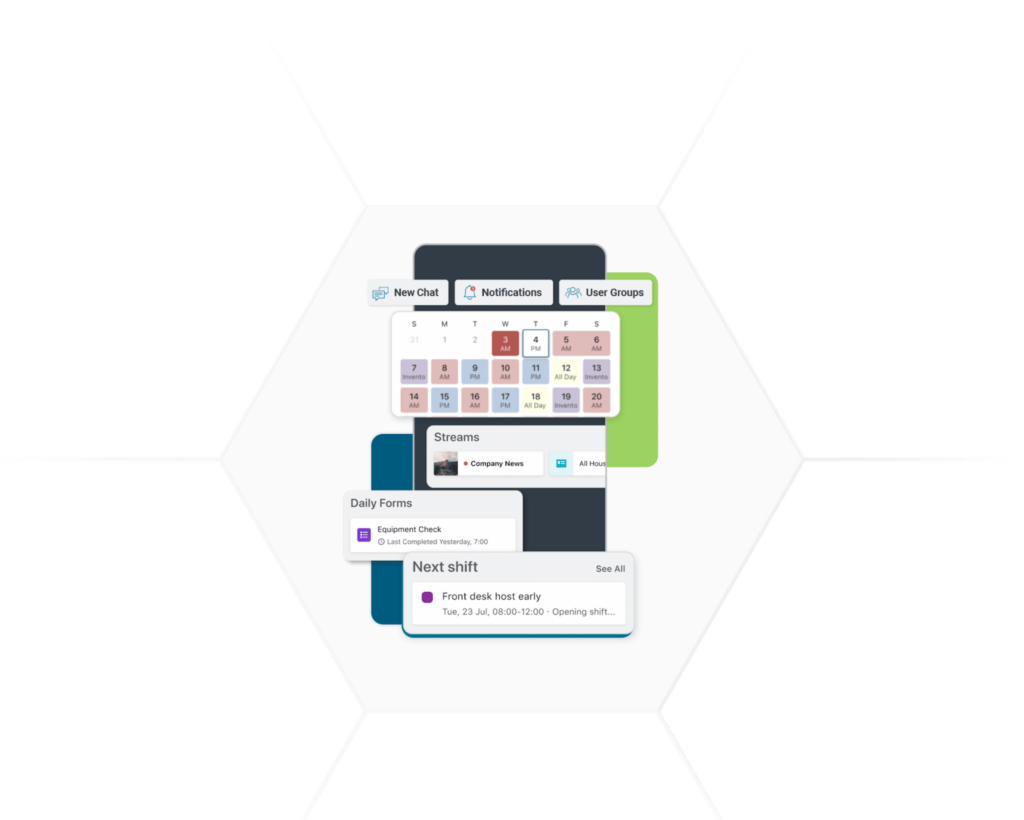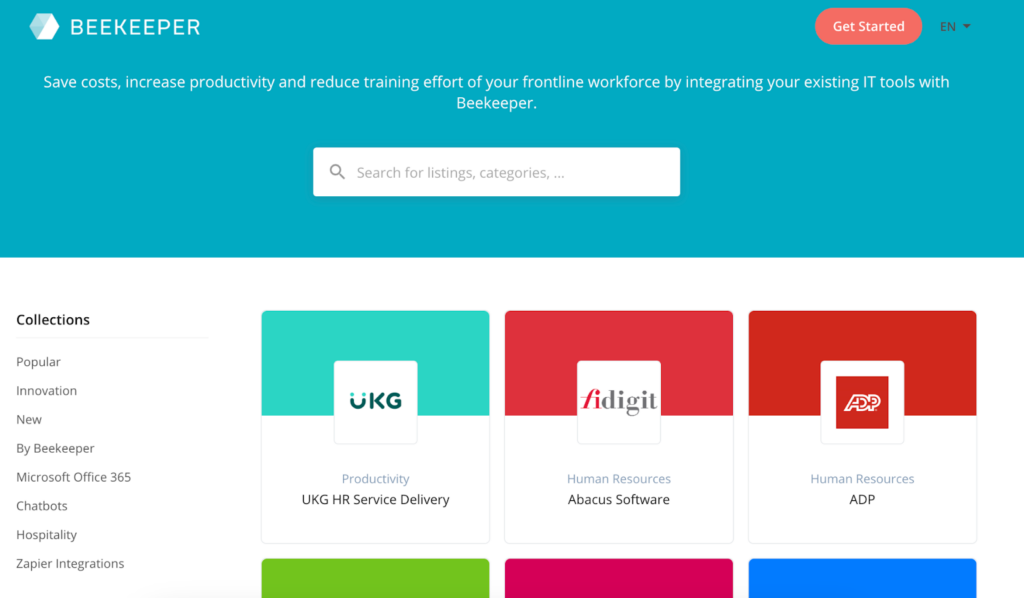
Table of contents
- What is a Modern Intranet?
- Interconnectivity: Modern Intranet, Digital Workplace, and Employee Experience
- The Core Elements of a Modern Intranet
- Types of Modern Intranet
- 10 Benefits of a Modern Intranet
- 10 Best Practices for Implementing a Modern Intranet
- The Impact of a Modern Intranet on Organizational Success
Clunky. Outdated. Slow. Siloed. One-way. Static. Have you guessed what we’re talking about yet? You got it: traditional office intranets. Company communication used to be hindered by this archaic (but once useful) tool. Fast forward to today: the modern intranet is the exact opposite: efficient, fast, integrated, two-way, and easy to use. Company communication has never been better.
What is a Modern Intranet?
A modern intranet is a contemporary and technologically advanced digital platform designed to facilitate communication, collaboration, and information-sharing within an organization. It serves as a centralized hub where employees can access resources, communicate with colleagues, and stay informed about company news and updates. Unlike traditional intranets that are static and less user-friendly, modern intranet tools are characterized by dynamic features and real-time accessibility.
Today’s intranet complements the way people work today: it prioritizes mobile accessibility, and is designed to be responsive across various platforms, including desktops, laptops, tablets, and smartphones. This ensures that employees can stay connected and access information from anywhere, fostering flexibility and agility in the modern workplace. In larger organizations, enterprise social networking (ESN) software is often one step beyond the intranet, capable of large-scale project management.
Unlock the secrets to employee engagement that truly work. Find out how North Point Hospitality engage their workforce.
A modern intranet is powered by cutting-edge internal communication software. It acts as a gateway to the broader digital workplace, offering employees a unified platform for accessing tools, resources, and applications crucial to their daily tasks. It also offers a higher level of security that companies need in the transfer of information. This can help protect against identity theft and other common cyberattacks.

Beekeeper offers a fully-encrypted platform that is ISO ISO 27001:2013, 27017:2015, 27018:2019 certified.
Interconnectivity: Modern Intranet, Digital Workplace, and Employee Experience
Using a modern intranet tool is a people-first strategy in today’s digital workplace. It is a digital home where employees can find the information they need to work more efficiently, connect with one another, and feel like a part of the community. This plays a pivotal role in shaping how employees feel about their jobs.
Today’s workers want:
- Digitally progressive employers
- Better relationships with their managers
- More transparency
- Greater flexibility
- More autonomy (68% of workers want this)
- Training and growth opportunities
The intranet provides all of this, and more. Especially for frontline workers. Companies have long overlooked them in workplace technology, investing just 1% of their budgets on tools that include them. The intranet changes that and includes every worker. Suddenly, the two billion workers in the world that are on the frontlines have the opportunity to be included in company communication. They feel valued, they feel heard, and they feel engaged.
The modern intranet also offers workforce automation that can help make onboarding easier, so employees feel connected to the company from day one. With automation and accessibility, the intranet makes work more efficient and empowers workers to be more productive. Employees navigate through an interface tailored to their roles, preferences, and responsibilities, ensuring that the information they need is at their fingertips. Simply being connected and having a voice creates a positive work culture, and fosters a sense of belonging and empowerment among employees.
The Core Elements of a Modern Intranet
There are several primary features of modern intranets that enhance their functionality and user experience. A modern intranet is built with components that collectively contribute to its effectiveness in facilitating internal communication, collaboration, and information-sharing within an organization that are designed to enhance user experience, promote engagement, and streamline workflows.
Here are the core elements of a modern intranet:
- User-Centric Design: An intuitive and user-friendly interface that prioritizes ease of use and accessibility is a hallmark of modern intranets. The design should be easy to navigate and responsive across various devices, providing a seamless experience for users regardless of whether they are accessing the intranet from a desktop, laptop, tablet, or smartphone.
- Mobile Accessibility: The ability for users to access the intranet from mobile devices is almost a requirement of today’s internet because it mirrors how workers live. In fact, Salesforce found that 71% of employees want digital tools and experience at work that they rely on in their personal lives. Mobile accessibility is crucial in today’s dynamic work environment, and is inclusive of the frontline workforce.
- Content Management System (CMS): This feature empowers non-technical users to update information, post announcements, and share resources without extensive technical knowledge. From social posts to company news, content is what keeps users engaged on the platform.
- Collaboration Tools: Integration of communication tools such as instant messaging, video conferencing, and project management applications directly within the intranet create a one-stop collaboration shop for employees and fosters greater productivity with a single sign-on feature.
- Social Features: While primarily a work tool, intranets have social elements like news feeds, liking, commenting, and user profiles that create a sense of community. Mimicking social media features helps foster engagement and encourages employees to interact with content and each other. Intranets often have employee directories so workers can connect with one another.
- Search Functionality: Robust search capabilities that allow users to quickly find the information they need is an important function of intranets which are designed to help make work easier. Advanced search features, filters, and algorithms contribute to the speed and accuracy of information retrieval, enhancing overall usability.
- Integration with Business Applications: Integration with other business applications and tools used within the organization, like document management systems, customer relationship management (CRM) software, scheduling, and other essential business applications, makes work easier and more efficient for administrators and workers alike.
- Personalization: Intranets have the ability to personalize content based on user roles, preferences, and responsibilities. Personalization ensures that users see relevant information tailored to their specific needs and responsibilities, enhancing the overall user experience.
- Analytics and Reporting: Built-in analytics tools that track user engagement, measure the effectiveness of content, and provide insights into how employees are using the intranet are part of the system’s backbone. Data-driven insights enable organizations to make informed decisions and continuously improve their strategies for better outcomes.
- Security Measures: Designed for the workplace, intranets have security measures to protect sensitive information and ensure compliance with data protection regulations. This includes features such as secure user authentication, role-based access control, and data encryption.
Types of Modern Intranet
Different intranet tools have different strengths and a company might go with one over another depending on business priorities and goals. For companies where team collaboration is most important, they might choose a product like Slack. For companies who want a strong mobile platform so employees can access from any device, they’ll go with Beekeeper.
Here are five different types of intranets.
1. Internal Website
This is how the modern intranet began: as an internal website. Though they have evolved quite a bit since they first appeared in the mid 1990s. These are internally-hosted (on company servers) websites designed for the employees of an organization and are primarily used for accessing company information.
2. Employee Intranet Portal
Unlike the basic internal website, an employee intranet portal is a more dynamic platform, offering a comprehensive space for employees to access important organizational information, guidelines, and processes. It’s hosted on the company’s servers and represents a more modern approach to intranets. It is a two-way communication portal, where employees can not only access information but can also contribute to the platform as well.
3. Social Intranet
Social intranets were originally designed to centralize content and enable workers to create team rooms for effective collaboration. But they can have fun, community-building aspects too (and they should!) They’ve expanded to incorporate more social-media like features such as news feeds, likes, comments, and user profiles to create a more interactive and engaging environment. A social intranet encourages employees to share information, contribute to discussions, and celebrate one another!
For example, a platform like Beekeeper is designed to connect employees of every level to foster collaboration and boost productivity. But companies can also create content that drives social engagement, like recognition streams, on the platform to build connection and community.

Beekeeper allows companies to customize the platform for style and branding
4. Front Door Intranet
Front door intranet is an entryway to the digital workplace that allows employees to access the tools, apps, and information to do their jobs. Employees can access the intranet on any device and serve as a “front door” to employee’s customized information (i.e. schedules).
5. Collaboration Intranet
Intranets should facilitate some level of connectedness, but collaboration platforms have features that specifically enable colleagues to work together, like document sharing, project management, and real-time exchange of communication and information. It enhances operational productivity by providing a centralized space for collaborative work.
Engaged employees are the cornerstone of exceptional customer service and heightened guest satisfaction. Discover how to foster a workplace where your team feels empowered, valued, and essential to your business’s success.
10 Benefits of a Modern Intranet
A modern intranet represents a transformative evolution from traditional static platforms. With its emphasis on user experience, mobile accessibility, collaboration tools, and integration capabilities, a modern intranet is a powerful tool for fostering communication, collaboration, and a sense of community within today’s workplace. And it should be one of a company’s top employee engagement strategies.
Here are the top benefit’s of today’s intranet options.
- Enhance Communication and Collaboration
- Centralize documents, information accessible to all
- Improved Productivity and Efficiency through streamlined processes
- Mobile Accessibility and Flexibility
- Customization and Personalization
- Integration with Other Tools
- Empower frontline workers with two-way communication
- Boosting employee engagement and satisfaction
- Ensure secure and compliant communication channels
- Provide real-time and remote access to company resources
10 Best Practices for Implementing a Modern Intranet
If you’re looking to upgrade your existing intranet, or looking for your first-ever modern intranet, here are 10 must-know and must-follow best practices to ensure the intranet is everything you need it to be.
1. Conduct a Thorough Needs Assessment
Before you can find the right tool that fits your needs, you need to know exactly what your organization needs: where are there gaps in communication? What is the make-up of your staff? What features do your employees need to be more productive? Conducting an assessment of your company’s needs will allow you to zero in on the right intranet tool that will optimize your operations and help you reach your business goals
2. Involve a Cross-Section of Employees in Planning
Choosing new software that will be used by everyone should not just be a C-suite decision. Have your HR team narrow down a list of possible solutions (using the needs assessment list.) Then, send the options out to everyone in the organization since they are all stakeholders. They will feel valued and included in this decision-making process and take ownership in this decision which will increase adoption rates and engagement.
3. Choose a Scalable and Flexible Platform
The whole reason you’re looking for a modern intranet tool is because the old ones are limited in features and scalability. You need a tool that will grow with your company and allow you to add tools and users. Your intranet needs to evolve with you so you don’t have to upgrade again a year from now. Look for a cloud-based tool, with a modular design for easy customization. Make sure the solution comes with the ability to receive cloud-based updates.
4. Prioritize User Experience and Design
Who will be using your intranet? That’s one of the first questions you should ask and answer. The platform needs to be designed for them, with ease of use to encourage high adoption rates. It should be a mobile-first platform so users can use the tool on the device they choose. The navigation structure must be user-friendly, with clear menus, search functionalities, and intuitive layouts and powerful search capabilities to help users find information quickly. Allow users to personalize their dashboards to display relevant information to help them in their work. Give them tools with integration features for a unified login experience and seamless access to other enterprise applications.

Centralize all workflows and documents in Beekeeper to create a fully digital experience.
5. Ensure Mobile Responsiveness and Accessibility
The core of any modern intranet is a mobile-first design. It is what sets it apart from the static old intranets that were only usable on laptops and desktops. Intranets of today need to be mobile to allow users to access the tools and information they need, wherever they are at that moment. That means faster work and higher productivity.
6. Integrate with Existing Systems and Tools
Integration with various business applications is a hallmark of modern intranets. They seamlessly connect with tools and systems such as document management, HR software, and customer relationship management (CRM) platforms which streamlines workflows, reduces silos, and enhances overall business process efficiency. Beekeeper Marketplace is an example of intranet integrations done right!

Smoothly transition your HR digital transformation with Beekeeper’s integration marketplace
7. Plan for Effective Content Management
Content management on an intranet involves the creation, organization, distribution, and maintenance of digital content within an organization’s internal network, and is crucial for maintaining a successful and continuously evolving intranet. And it’s what will keep your audience (your employees) engaged on the platform. Content should be easily searchable and customized to users. It should be transparent, and contain the information employees need to know and access, from safety to open enrollment. Integrate analytics tools to track user engagement, content popularity, and interactions. Use insights to assess the effectiveness of content and make data-driven improvements.
8. Robust Security Measures
It goes without saying that a company intranet must have strong security, much more than the typical social apps. Use firewalls to monitor and control incoming and outgoing network traffic. Configure firewalls to allow only necessary and authorized communication. Use secure protocols for file transfers within the intranet (e.g., SFTP) to protect data during transit. Beekeeper offers a powerful security that allows for companies to focus on engagement without worrying about security breaches through a mobile tool.
9. Facilitate Training and User Adoption
When you roll out your intranet, offer training to teach employees how to get started. Sure, the platform might be intuitive for many. But for some employees, change can be hard. Showing people how to use the new tool can boost adoption rates from initial roll outs. And if you use Beekeeper, you get access to our range of learning resources like webinars, case studies, e-books and a central resource hub, all under one roof!
Gain insights into innovative strategies that go beyond conventional approaches, for a more engaged and productive workforce.
10. Monitor and Gather Feedback for Continuous Improvement
Modern intranets allow you to gather feedback from users to continually improve the intranet’s functionality and content. Implement feedback features, such as surveys or comments, to gather input on what areas need improvement and take action to address them. Regular assessments, feedback loops, and proactive adjustments are key to maintaining a vibrant and effective intranet.
With Beekeeper, you can easily create polls and surveys and set a timeframe. You can even anonymize the responses to avoid bias feedback. And if you learn better with video, here’s a quick sneak peek into creating surveys.
The Impact of a Modern Intranet on Organizational Success
Modern intranets influence every aspect of a business environment: efficiency, communication, collaboration, and overall employee engagement. As technology evolves, modern intranets have become integral tools that significantly contribute to an organization’s ability to thrive and influence organizational success. With Beekeeper, companies can feel good about using the right tool to connect their organization. With one centralized platform, everyone is aligned to a modern intranet with seamless communication for the ultimate intranet goal—a better employee experience.
Want to optimize your HR strategy and maximize employee success? Learn more about the power of employee engagement with Beekeeper and how it can revolutionize your frontline organization.

About the author
Stacie Pahl







